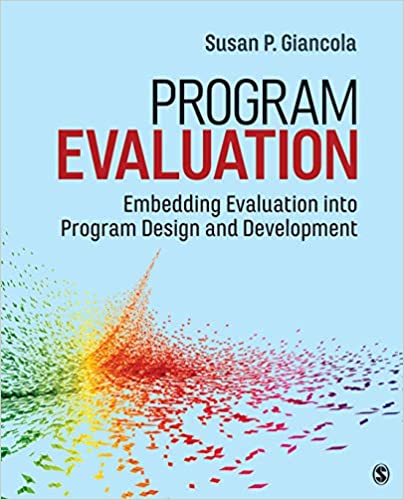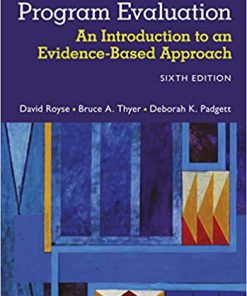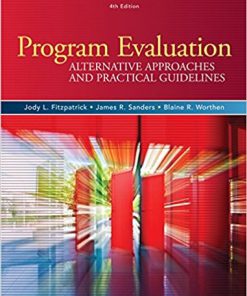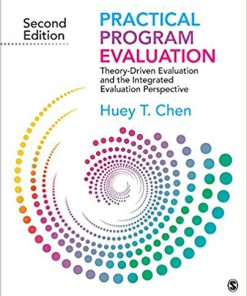(eBook PDF) Program Evaluation: Embedding Evaluation into Program Design and Development
$50.00 Original price was: $50.00.$35.00Current price is: $35.00.
(eBook PDF) Program Evaluation: Embedding Evaluation into Program Design and Development – Instant Download
(eBook PDF) Program Evaluation: Embedding Evaluation into Program Design and Development – Digital Ebook – Instant Delivery Download

product details:
- ISBN-10 : 150635744X
- ISBN-13 : 978-1506357447
- Author: Susan P. Giancola
Program Evaluation: Embedding Evaluation into Program Design and Development provides an in-depth examination of the foundations, methods, and relevant issues in the field of evaluation. With an emphasis on an embedded approach, where evaluation is an explicit part of a program that leads to the refinement of the program, students will learn how to conduct effective evaluations that foster continual improvement and enable data-based decision making. This book provides students with both the theoretical understanding and the practical tools to conduct effective evaluations while being rigorous enough for experienced evaluators looking to expand their approach to evaluation. Susan P. Giancola’s clear language and presentation style make the book’s concepts accessible, and opportunities for self-review and application offer ample practice.
table of contents:
SECTION I • INTRODUCTION
Chapter 1 • Evaluation Matters
1.1 What Is Evaluation?
1.2 Why Evaluate?
1.3 Values and Standards in Evaluation
1.4 Types of Evaluation
1.5 Internal and External Evaluation
1.6 Embedding Evaluation Into Programs
1.7 Textbook Organization
1.8 Chapter Summary
Reflection and Application
Chapter 2 • History of Evaluation
2.1 The Evolution of Evaluation
2.2 The History of Ethics in Research and Evaluation
2.3 Current Issues in Evaluation
2.4 Chapter Summary
Reflection and Application
Chapter 3 • Evaluation Ethics
3.1 Ethics Defined
3.2 Research Ethics Guidelines and Legislation
3.3 IRB Protocols and Amendments
3.4 Ethical Responsibilities of Organizations
3.5 Ethical Responsibilities of Evaluators
3.6 Additional Considerations
3.7 Chapter Summary
Reflection and Application
Chapter 4 • Evaluation Ideologies and Approaches
4.1 Inquiry and Ideology
4.2 Evaluation Ideology
4.3 Evaluation Design
4.4 Evaluation Approach
4.5 Embedded Evaluation
4.6 Chapter Summary
Reflection and Application
SECTION II • EMBEDDED EVALUATION: DESIGN
Chapter 5 • DEFINE, Part 1: Understanding the Program
5.1 Embedded Evaluation
5.2 Understanding the Program
5.3 Delineating Goals and Strategies
5.4 Explaining the Program Theory
5.5 Determining Contextual Conditions
5.6 Program Theory and Other Theories
5.7 Considering Alternative Theories
5.8 Chapter Summary
Reflection and Application
Chapter 6 • DEFINE, Part 2: Modeling the Program
6.1 Chapter in Context
6.2 What Is a Logic Model?
6.3 Creating the Logic Model
6.4 Using the Program’s Logic Model
6.5 More on Logic Models
6.6 Chapter Summary
Reflection and Application
Chapter 7 • PLAN, Part 1: Planning the Evaluation
7.1 Creating Evaluation Questions
7.2 Embedding Evaluation Questions Into Your Logic Model
7.3 What Data Should I Collect?
7.4 Creating the Evaluation Matrix
7.5 Chapter Summary
Reflection and Application
Chapter 8 • PLAN, Part 2: Designing the Evaluation
8.1 Evaluation Design
8.2 Evaluation Methods and Tools
8.3 Evaluation Matrix: Identifying Data Sources
8.4 Chapter Summary
Reflection and Application
SECTION III • EMBEDDED EVALUATION: IMPLEMENTATION
Chapter 9 • IMPLEMENT, Part 1: Implementing the Evaluation
9.1 Chapter in Context
9.2 Informed Consent
9.3 Collecting the Data
9.4 Organizing Quantitative Data
9.5 Organizing Qualitative Data
9.6 Chapter Summary
Reflection and Application
Chapter 10 • IMPLEMENT, Part 2: Analyzing the Data
10.1 Chapter in Context
10.2 Quantitative Data Analysis: Descriptive Statistics
10.3 Quantitative Data Analysis: Inferential Statistics
10.4 Qualitative Data Analysis
10.5 Managing the Unexpected and Unintended
10.6 Chapter Summary
Reflection and Application
Chapter 11 • INTERPRET: Interpreting the Results
11.1 The Home Stretch
11.2 Examining Results
11.3 Interpreting Results
11.4 Communicating Evaluation Results
11.5 Enhancing Reporting and Communication
11.6 Chapter Summary
Reflection and Application
Chapter 12 • INFORM and REFINE: Using Evaluation Results
12.1 Purpose of Evaluation
12.2 Pre-Evaluation: Efforts to Promote Utilization
12.3 During Evaluation: Ongoing Utilization Efforts
12.4 Post-Evaluation and Data Dissemination
12.5 Chapter Summary
Reflection and Application
SECTION IV • RESOURCES
Chapter 13 • Case Study Applications
13.1 LEND Evaluation
13.2 ACCEL Evaluation
13.3 YAP Evaluation
people also search:
You may also like…
Computers & Technology
(eBook PDF) C++ Programming: From Problem Analysis to Program Design 7th
Computers & Technology
(eBook PDF) Java Foundations: Introduction to Program Design and Data Structures 5th Edition











